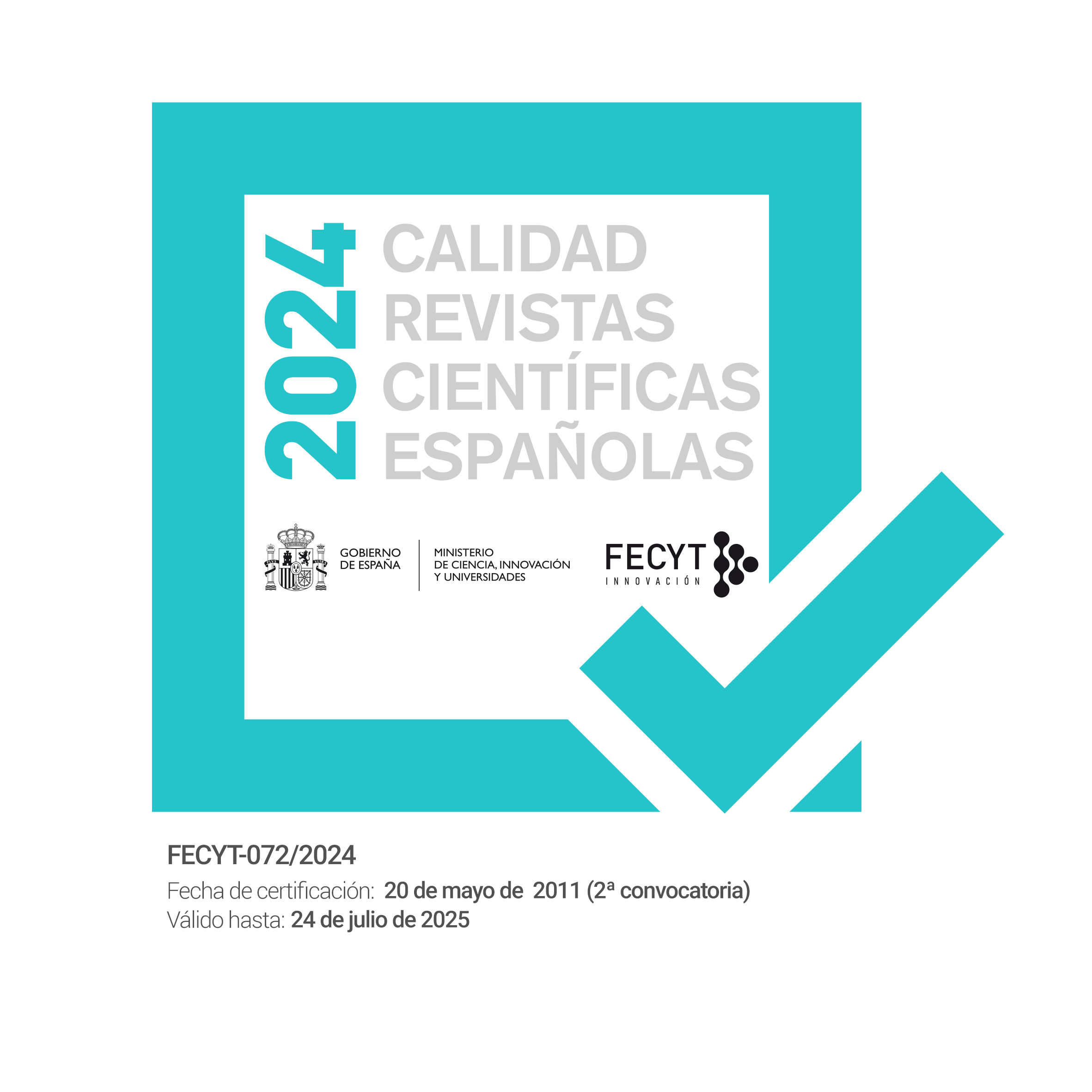Notas sobre la biología y enemigos naturales de Polyphagozerra coffeae (Nietner, 1861) infestando el árboles Eucalyptus pellita F. Muell. (Myrtaceae) en Riau, Indonesia (Lepidoptera: Cossidae, Zeuzerinae)
DOI:
https://doi.org/10.57065/shilap.398Palabras clave:
Lepidoptera, Cossidae, Zeuzerinae, Cossidophaga coffeae, daños, Eucalyptus grandis, parasitoides, Zeuzera coffeae, Sumatra, IndonesiaResumen
Polyphagozerra coffeae (Nietner, 1861) (Lepidoptera: Cossidae) es uno de los más destructivos taladradores en el mundo. El objetivo de este estudio fue identiticar y evaluar algunos parámetros biológicos de P. coffeae en laboratorio. También fueron identificadas las especies como enemigos naturales y los daños causados sobre Eucalyptus (Myrtaceae) por esta plaga en Riau, Sumatra, Indonesia. Los Lepidoptera fueron identificados como P. coffeae después de analizar la morfología externa y el aedeagus (genitalia del macho). El 1.66 ± 0.28 día de las viejas hembras eran capaces de producir un promedio 591.80 ± 126.33 huevos por individuo. Las orugas se quedaron en el tallo de árbol por un período superior a los 60 días. Fueron recobrados los enemigos naturales de cinco grupos de P. coffeae. Fueron Brachymeria sp. (Hymenoptera: Chalcididae) como un hyperparasitoide de Cossidophaga coffeae Tachi & Shima, 2020 (Diptera: Tachinidae) parasitando la oruga, Metarhizium sp. (Hypocreales: Clavicipitaceae), un Eulophidae, Tetrastichinae (endoparásito pupal), un Nematoda (parásito pupal) y C. coffeae (parásito larval). Los daños causados por las larvas de P. coffeae sobre los árboles de Eucalyptus son las galerías y las cámaras de pupación. Desde la bibliografía examinada, se han registrado sesenta y nueve especies de plantas pertenecientes a 30 familias, como plantas huesped de P. coffeae. El corriente estudio incluye Eucalyptus pellita F. Muell. y E. pellita × Eucalyptus grandis W. Hill ex Maiden como planta huesped de esta plaga.
Descargas
Citas
ABRAHAM, C. C. & SKARIA, B. P., 1995.– New record of the red borer Zeuzera coffeae Nietner (Cossidae: Lepidoptera) as a pest of allspice, Pimenta dioica (Linn.) Merril.– Insect Environment, 1(1): 1-6.
AGUSTINI, L., FRANCIS, A., GLEN, M., INDRAYADI, H. & MOHAMMED, C. L., 2014.– Signs and identification of fungal root-rot pathogens in tropical Eucalyptus pellita plantations.– Forest Pathology, 44(6): 486-495. DOI: https://doi.org/10.1111/efp.12145
AHMAD, I., 2017.– Integrated pest management of Zeuzera coffeae Nietner: an efficient approach to reduce the infestation of walnut trees.– Pakistan Journal of Zoology, 49(2): 693-698. DOI: https://doi.org/10.17582/journal.pjz/2017.49.2.693.698
ARORA, G. S., 1976.– A taxonomic revision of the Indian species of the family Cossidae (Lepidoptera).– Records of the Zoological Survey of India, 69(1): 1-160. DOI: https://doi.org/10.26515/rzsi/v69/i1-4/1971/161406
BEESON, C. F. C., 1941.– The ecology and control of the forest insects of India and the neighbouring countries: 1007 pp. Vasant press, Dehra Dun.
CAB INTERNATIONAL, 2003.– Crop Protection Compendium 2003. CABI, Wallingford.
CAB INTERNATIONAL, 2014.– Stem borer. Crop Protection Compendium. Available from http://www.cocoasafe.org/Resources%5CDatasheets%5CStemBorer.pdf (Accessed on 06 June 2018).
CAB INTERNATIONAL, 2018.– Zeuzera coffeae (coffee carpenter). Invasive Species Compendium. Available from https://www.cabi.org/isc/datasheet/57492 (Accessed on 19 June 2018).
GAFUR, A., NASUTION, A., YULIARTO, M., YONG, W. C. & SHARMA, M., 2015.– A new screening method for Ganoderma philippii tolerance in tropical Acacia species.– Southern Forests, 77(1): 75-81. DOI: https://doi.org/10.2989/20702620.2014.999304
CHANG, C. P., 1984.– The morphology and life history of the coffee borer (Zeuzera coffeae Nietner) on grapevine in Taiwan.– Plant Protection Bulletin, 26(2): 145-153.
GARDNER, J. C. M., 1945.– Immature stages of Indian Lepidoptera (Cossidae, Indarbelidae).– Journal of the Bombay Natural History Society, 45(1): 390-395.
GILL, W., EYLES, A., GLEN, M. & MOHAMEED, C., 2016.– Structural host responses of Acacia mangium and Eucalyptus pellita to artificial infection with the root rot pathogen, Ganoderma philippii.– Forest Pathology, 46(4): 369-375. DOI: https://doi.org/10.1111/efp.12286
GOPINATH, K., 1962.– Studies on the braconid, Amyosoma zeuzerae Rohwer an ectoparasite of the coffee red borer, Zeuzera coffeae Nietner.– Current Science, 31(1): 5-6.
GOUD, K. B., KUMARI, N. K., VASTRAD, A. S., BHADRAGOUDAR, M. & KULKARNI, H., 2010.– Screening of eucalyptus genotypes against gall wasp, Leptocybe invasa Fisher and La Salle (Hymenoptera: Eulophidae).– Karnataka Journal of Agricultural Sciences, 23(1): 213-214.
GUL, H. & WALI-UR-REHMAN, 1999.– A note on walnut borer, Zeuzera coffeae (Cossidae: Lepidoptera) on walnut trees (Juglans regia) in district Dir.– Pakistan Journal of Forestry, 49(1/4): 117-120.
HARDIE, M., MENDHAM, D., CORKREY, R., HARDIYANTO, E., MAYDRA, A., SIREGAR, S., MAROLOP, R. & WIBOWO, A., 2018.– Effects of Eucalypt and Acacia plantations on soil water in Sumatra.– New Forests, 49(1): 87-104. DOI: https://doi.org/10.1007/s11056-017-9607-3
HII, S. Y., HA, K. S., NGUI, M. L., AK PENGUANG JNR, S., DUJU, A., TENG, X. Y. & MEDER, R., 2017.– Assessment of plantation-grown Eucalyptus pellita in Borneo, Malaysia for solid wood utilisation.– Australian Forestry, 80(1): 26-33. DOI: https://doi.org/10.1080/00049158.2016.1272526
KALSHOVEN, L. G. E., 1940.– Observations on the red branch borer, Zeuzera coffeae Nietn. (Lep. Coss.).– Entomologische Mededeelingen van Nederlandanasch-Indie, 6(1): 50-56.
KEMP, J. E., LOVATT, R. J., BAHR, J. C., KAHLER, C. P. & APPELMAN, C. N., 2007.– Pre-clearing vegetation of the coastal lowlands of the Wet Tropics Bioregion, North Queensland.– Cunninghamia, 10(2): 285-329.
LADELL, W. R. S., 1927.– Some injurious insects in Siam.– Journal of the Siam Society Natural History Supplement, 7(1): 101-105.
LE, S., NOCK, C., HENSON, M. & SHEPHERD, M., 2009.– Genetic differentiation among and within three red mahoganies (series Annulares), Eucalyptus pellita, E. resinifera and E. scias (Myrtaceae).– Australian Systematic Botany, 22(5): 332-343. DOI: https://doi.org/10.1071/SB09004
LEE, M. H. & BAE, D. H., 2015.– Climate change impact assessment on green and blue water over Asian monsoon region.– Water Resources Management, 29(7): 2407-2427. DOI: https://doi.org/10.1007/s11269-015-0949-3
MISHRA, S. B., KENCHARADDI, R. N., DEVAGIRI, G. M. & KHAPLE, A. K., 2016.– Moths diversity of Kodagu District in Central Western Ghats of Karnataka, India.– Indian Journal of Ecology, 43(2): 713-718.
PALLAS, B., MIALET-SERRA, I., ROUAN, L., CLÉMENT-VIDAL, A., CALIMAN, J. P. & DINGKUHN, M., 2013.– Effect of source/sink ratios on yield components, growth dynamics and structural characteristics of oil palm (Elaeis guineensis) bunches.– Tree Physiology, 33(4): 409-424. DOI: https://doi.org/10.1093/treephys/tpt015
PKB, 2017.– Coffee carpenter (Zeuzera coffeae). Plantwise Knowledge Bank. Available from http://www.plantwise.org/KnowledgeBank/Datasheet.aspx?dsid=57492 (Accessed on 22 June 2018).
PRASETYO, A., AISO, H., ISHIGURI, F., WAHYUDI, I., WIJAYA, I. P. G., OHSHIMA, J. & YOKOTA, S., 2017.– Variations on growth characteristics and wood properties of three Eucalyptus species planted for pulpwood in Indonesia.– Tropics, 26(2): 59-69. DOI: https://doi.org/10.3759/tropics.MS16-15
QUICKE, D. L. J. & WHARTON, R. A., 1989.– Myosoma nyanzaensis sp. n. (Hymenoptera: Braconidae) parasitic on the stem-borer pest Chilo partellus (Swinhoe) (Lepidoptera: Pyralidae) in Kenya.– Bulletin of Entomological Research, 79(1): 1-6. DOI: https://doi.org/10.1017/S0007485300018514
SAMIKSKA, S., 2017.– Red borer (Zeuzera coffeae): Distribution, life cycle and control. YourArticleLibrary.com. Available from http://www.yourarticlelibrary.com/zoology/red-borer-zeuzera-coffeae-distribution-life-cycleand-control/24052/ (Accessed on 22 June 2018).
SRIDHAR, V., SINGH, H. S. & PANDEY, V., 2002.– Record of Zeuzera coffeae Nietner (Lepidoptera: Cossidae) as a pest of custard apples (Annona spp.) from the coastal area of Orissa.– Progressive Horticulture, 34(1): 128-129.
SATHIAMMA, B. & BHAT, K. S., 1974.– Record of a stem borer on cacao from India.– Journal of Plantation Crops, 2(2): 34-35.
SIAGIAN, M. & SIMARMATA, A. H., 2018.– Trophic status of the lacustrine zone around the dam site of Koto Panjang Reservoir, Riau Province, Indonesia.– AACL Bioflux, 11(1): 1-9.
SMETACEK, P., 2008.– Moths recorded from different elevations in Nainital District, Kumaon Himalaya, India.– Bionotes, 10(1): 5-15.
SUNDARARAJ, R., WILSON, J. J. & VIMALA, D., 2019.– Stem borers of Indian sandalwood (Santalum album Linn.) in Karnataka, India.– Journal of the Indian Academy of Wood Science, 16(1): 31-35. DOI: https://doi.org/10.1007/s13196-019-00232-1
SUSANTI, W., ADNAN, A., YENDRA, R. & MUHAIJIR, M. N., 2018.– The analysis of extreme rainfall events in Pekanbaru city using three-parameter generalized extreme value and generalized Pareto distribution.– Applied Mathematical Sciences, 12(2): 69-80. DOI: https://doi.org/10.12988/ams.2018.712355
TACHI, T., SHIMA, H., TAVARES, W. DE S. & TARIGAN, M., 2020.– A new species of Cossidophaga Baranov from Indonesia (Diptera: Tachinidae), a parasitoid of the carpenter moth, Polyphagozerra coffeae (Nietner) (Lepidoptera: Cossidae).– Oriental Insects, DOI: 10.1080/00305316.2019.1697386. DOI: https://doi.org/10.1080/00305316.2019.1697386
TAMS, W. H. T., 1927.– List of the moths collected in Siam by E. J. Godfrey, B. Sc., F. E. S. with description of new species.– Journal of Natural History Society of Siam, 6(1): 229-289.
TOXOPEUS, L. J., 1948.– On the borer moths Zeuzera coffeae Nietn, and Z. roricyanea Wlk. (neuropunctata Gaede) (Lep., Cossidae, Zeuzerinae).– Treubia, 19(1): 167-175.
VOS, R., 2017.– The goat moths (Lepidoptera: Cossidae) of Papua Indonesia. Available from http://www.papuainsects.nl/insect%20orders/Lepidoptera/Cossidae/Zeuzera/Zeuzera%20coffeae.htm (Accessed on 22 June 2018).
WALLER, J. M., BIGGER, M. & HILLOCKS, R. A., 2007.– Coffee pests, diseases and their management. 1-400. Available from https://books.google.co.id/books?id=RpcoIgUBOLoC&pg=PA61&redir_esc=y#v=onepage&q&f=false (Accessed on 22 June 2018). DOI: https://doi.org/10.1079/9781845931292.0000
YAKOVLEV, R. V., 2005.– Cossidae (Lepidoptera) of Andaman Islands (India).– Tinea, 18(1): 257-260.
YAKOVLEV, R. V., 2011.– Catalogue of the family Cossidae of the Old World.– Neue Entomologische Nachrichten, 66(1): 1-129.
YAKOVLEV, R. V., 2012.– Trophic relations of Old World carpenter-moths (Lepidoptera, Cossidae).– Euroasian Entomological Journal, 11(1): 189-194.
YAKOVLEV, R. V., 2014.– Descriptions of three new species of Cossidae (Lepidoptera) from Vietnam, with an updated annotated checklist.– Zootaxa, 3802(1): 240-256. DOI: https://doi.org/10.11646/zootaxa.3802.2.6
YAKOVLEV, R. V., 2015.– Patterns of geographical distribution of carpenter moths (Lepidoptera: Cossidae) in the Old Word.– Contemporary Problems of Ecology, 8(1): 36-50. DOI: https://doi.org/10.1134/S1995425515010151
YAKOVLEV, R. V. & ALIPANAH, H., 2017.– Description of the male genitalia of Dyspessa wiltshirei Daniel, 1938 (Lepidoptera, Cossidae) based on the type specimens.– Ukrainian Journal of Ecology, 7(1): 108-110. DOI: https://doi.org/10.15421/2017_56
YAKOVLEV, R. V. & WITT, T. J., 2017a.– Redescription of the genus Paralophonotus Schoorl, 1990 based on the morphology of male genitalia (Lepidoptera: Cossidae).– SHILAP Revista de lepidopterología, 45(180): 665-668.
YAKOVLEV, R. V. & WITT, T. J., 2017b.– Three new species and one new subspecies of Deserticossus Yakovlev, 2006 (Lepidoptera: Cossidae) from Kazakhstan, Kyrgyzstan and Russia, with world catalogue of the genus.– Zootaxa, 4269(3): 379-395. DOI: https://doi.org/10.11646/zootaxa.4269.3.3
YUNIARTI, N., MEGAWATI, M. & LEKSONO, B., 2017.– The effect of method and germination paper substrate on viability of Eucalyptus pellita F. Mull seed.– Jurnal Penelitian Kehutanan Wallacea, 6(1): 13-19. DOI: https://doi.org/10.18330/jwallacea.2017.vol6iss1pp13-19
YUSKIANTI, V., GLEN, M., PUSPITASARI, D., FRANCIS, A., RIMBAWANTO, A., GAFUR, A., INDRAYADI, H. & MOHAMMED, C. L., 2014.– Species-specific PCR for rapid identification of Ganoderma philippii and Ganoderma mastoporum from Acacia mangium and Eucalyptus pellita plantations in Indonesia.– Forest Pathology, 44(6): 477-485. DOI: https://doi.org/10.1111/efp.12144
Descargas
Publicado
Cómo citar
Número
Sección
Licencia
Derechos de autor 2020 W. de S. Tavares, S. K. Kkadan, A. M. Hendrik, M. Tarigan, R. Asfa, R. V. Yakovlev, T. Tachi, A. Duran, C. Y. Wong, M. Sharma

Esta obra está bajo una licencia internacional Creative Commons Atribución 4.0.
El autor retiene sus derechos de marca y patente sobre cualquier proceso o procedimiento dentro del artículo.
El autor retiene el derecho de compartir, distribuir, ejecutar y comunicar públicamente el artículo publicado en SHILAP Revista de lepidopterología, con reconocimiento inicial de su publicación en SHILAP Revista de lepidopterología.
El autor retiene el derecho para hacer una posterior publicación de su trabajo, de utilizar el artículo a publicarlo en un libro, siempre que indique su publicación inicial en SHILAP Revista de lepidopterología.
Cada envío a SHILAP Revista de lepidopterología debe ir acompañado de una aceptación de los derechos de autor y del reconocimiento de autoría. Al aceptarlos, los autores conservan los derechos de autor de su trabajo y aceptan que el artículo, si es aceptado para su publicación por SHILAP Revista de lepidopterología, tendrá una licencia de uso y distribución “Reconocimiento 4.0 Internacional de Creative Commons” (CC BY 4.0), que permite a terceros compartir y adaptar el contenido para cualquier propósito dando el crédito apropiado al trabajo original.
Puede consultar desde aquí la versión informativa y el texto legal de la licencia. La indicación de la licencia CC BY 4.0 debe indicarse expresamente de esta manera cuando sea necesario.
A partir de 2022, el contenido de la versión impresa y digital se encuentra bajo una licencia de uso y distribución “Reconocimiento 4.0 Internacional de Creative Commons” (CC BY 4.0), que permite a terceros compartir y adaptar el contenido para cualquier propósito dando el crédito apropiado al trabajo original.
El contenido anterior de la revista se publicó bajo una licencia tradicional de derechos de autor; sin embargo, el archivo está disponible para acceso gratuito.
Al usar el contenido de SHILAP Revista de lepidopterología publicado antes del año 2022, incluidas figuras, tablas o cualquier otro material en formato impreso o electrónico pertenecen a los autores de los artículos, los autores deben obtener el permiso del titular de los derechos de autor. Las responsabilidades legales, financieras y penales a este respecto pertenecen al autor(es).
En aplicación del Principio de Prioridad del Código Internacional de Nomenclatura Zoologica, no se autoriza el depósito en repositorios, páginas web personales o similares de cualquier otra versión distinta a la publicada por el editor.





























